DAWN breaks over Belfast. A van and a minibus rattle through the city and head down the main road towards Dublin, stopping only at the cross-border road block on the hills above Newry where a British squaddie peers at our luggage. An unfriendly machine-gun pokes from a bunker in the heather. You see this sort of thing on the telly but don’t realise how unnerving it is until the gun is pointing directly at your body. But by mid-afternoon that’s all behind us, and we have reached the Wicklow Mountains and the quiet valley of Glendalough. This is where our adventure begins . . .
This is a retro post for Because They???re There. It???s a letter from the past featuring an expedition to Eire and the contemporary events surrounding it . . .
Like Cornwall, Wales and parts of England, the rocky coasts and wild uplands of Ireland have been exploited for their mineral wealth since Bronze Age times. Scars have been inflicted on the landscape and many miles of tunnels and vast chambers lie hidden in the earth.
The allure of these deep and secret places has brought us across the Irish Sea with a load of caving gear on an expedition to find and explore the ancient workings. We belong to a group called the Cumbria Amenity Trust Mining History Society, and this is our second visit to Eire.
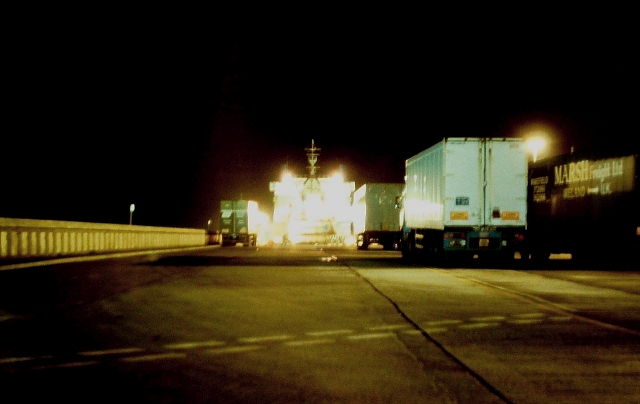
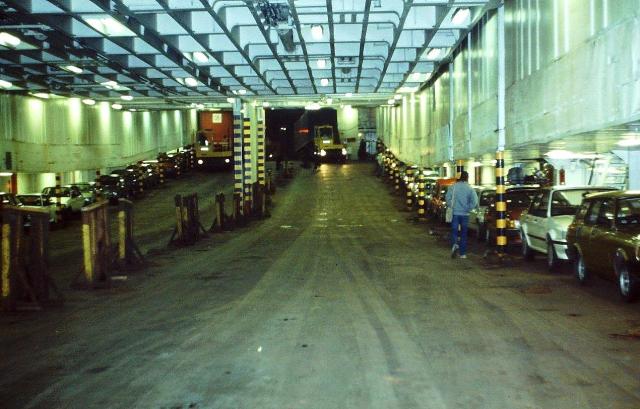
 Our itinerary includes the lead mines of Glendalough and the copper mines of Avoca, both of which are situated in the Wicklow Mountains; the copper mines of Brow Head, near Mizen Head, from where Guglielmo Marconi is said to have made the first radio contact with America; and the huge and ancient copper mines at Allihies in the far west of County Cork.
Our itinerary includes the lead mines of Glendalough and the copper mines of Avoca, both of which are situated in the Wicklow Mountains; the copper mines of Brow Head, near Mizen Head, from where Guglielmo Marconi is said to have made the first radio contact with America; and the huge and ancient copper mines at Allihies in the far west of County Cork.
 The expedition involves many long hours of driving along winding roads. But we have much to talk about. Buckingham Palace has just announced the engagement of Prince Andrew and Sarah Ferguson (we wish them a long and happy married life); a tabloid newspaper called Today has been launched by entrepreneur Eddy Shah (we expect this will be a huge success); the Sun has alleged that comedian Freddie Starr ate a hamster (my wife knows a better story about him when he was doing a gig in Barrow); and a treaty has been signed to end the 335-year war between Holland and the Scilly Isles (the world is now a safer place, we agree).
The expedition involves many long hours of driving along winding roads. But we have much to talk about. Buckingham Palace has just announced the engagement of Prince Andrew and Sarah Ferguson (we wish them a long and happy married life); a tabloid newspaper called Today has been launched by entrepreneur Eddy Shah (we expect this will be a huge success); the Sun has alleged that comedian Freddie Starr ate a hamster (my wife knows a better story about him when he was doing a gig in Barrow); and a treaty has been signed to end the 335-year war between Holland and the Scilly Isles (the world is now a safer place, we agree).
I’m not going to say much more. We have seven days of tramping across hills, poking about in old mine-workings, camping in shaded valleys and on sandy beaches, drinking Guinness, travelling quiet byways, meeting wonderful people and soaking up the atmosphere of Europe’s western-most country.
As someone once said: when you are standing on the cliffs at Allihies, and blue waves are crashing on the shingle below, the next parish is New York. I’ll let the picture captions say the rest . . .
Memories of Ireland’s deep secrets, spring 1986

Chris D Jones gets geared up to abseil down a shaft, watched by Mike Mitchell, left, and Peter Blezard
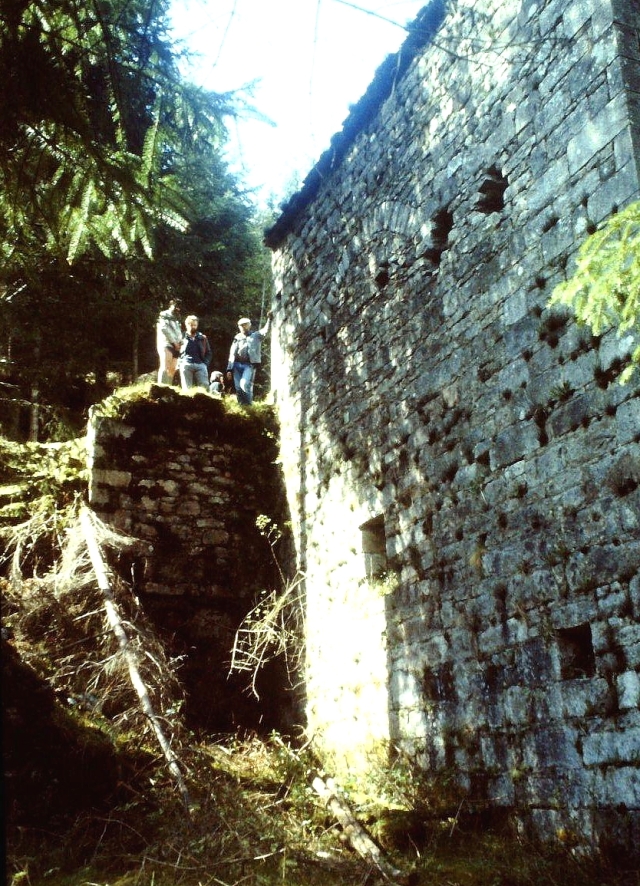 Leaving Glendalough we move a few miles to Avoca. This area has been mined for copper since Bronze Age times, and the mines were still being worked when we last visited in 1983. But the operation has since closed down and things are now being sold off. Avoca was the setting for the TV series Ballykissangel, and apparently the 1966 film Jules Verne’s Rocket to the Moon was also filmed here. It’s an interesting area with pretty valleys, rolling hills, and the ruins of Cornish engine houses set in bleak industrial landscapes.
Leaving Glendalough we move a few miles to Avoca. This area has been mined for copper since Bronze Age times, and the mines were still being worked when we last visited in 1983. But the operation has since closed down and things are now being sold off. Avoca was the setting for the TV series Ballykissangel, and apparently the 1966 film Jules Verne’s Rocket to the Moon was also filmed here. It’s an interesting area with pretty valleys, rolling hills, and the ruins of Cornish engine houses set in bleak industrial landscapes.
We move on along the south coast in the direction of County Cork ??? but one of the vans breaks down in Waterford.

Just to illustrate that when boys are on holiday together, with a little effort they can be as tidy as they are at home
We head into the west and find a campsite at a village called Schull, in the deep south of County Cork. The next morning we drive to the southernmost tip of Ireland ??? Brow Head ??? to explore the old copper mines. The mine entrances are located part-way down sheer cliffs, and gaining access involves abseiling and some dodgy climbing. We presume the miners used ladders and had decent pathways that have since washed away.
We move on to Allihies on the Bearhaven peninsula. This is about as far west as it gets. The copper mines descended more than 1,000ft beneath the sea. It’s like Cornwall only with Guinness and without the holidaymakers. It really is a beautiful part of the world.

Alastair Lings knocks rocks about with his hammer. Alastair used to work for gold prospecting companies in Scotland (at Tyndrum) and Ireland (Sperrin Mountains), so when it comes to geology he knows his stuff. He is also sanitation advisor to the Mountain Bothies Association. A useful bloke.

Three amigos. From left, in the fetching yellow suit, is myself, Mike Mitchell eating a banana, and Alastair Lings.

By the end of the week we are all beginning to wilt. Anne Danson is so tired she can sleep on a stone slab
FOOTNOTE: This blog post was inspired by Hanna Greenwood’s series of posts about a reconstructed Viking longship called the Sea Stallion from Glendalough. The remains of the original longship (known by archaeologists as Skuldelev 2) were discovered in shallow water near Roskilde, Denmark, in 1962. Tree-ring dating determined that the ship was built around 1042 near Dublin with oak from Glendalough. The reconstruction, Sea Stallion, was built between 2000 and 2004 and sailed from Denmark to Dublin in 2007. It is now used for research. You can see Hanna’s posts on her website, Vandreture.










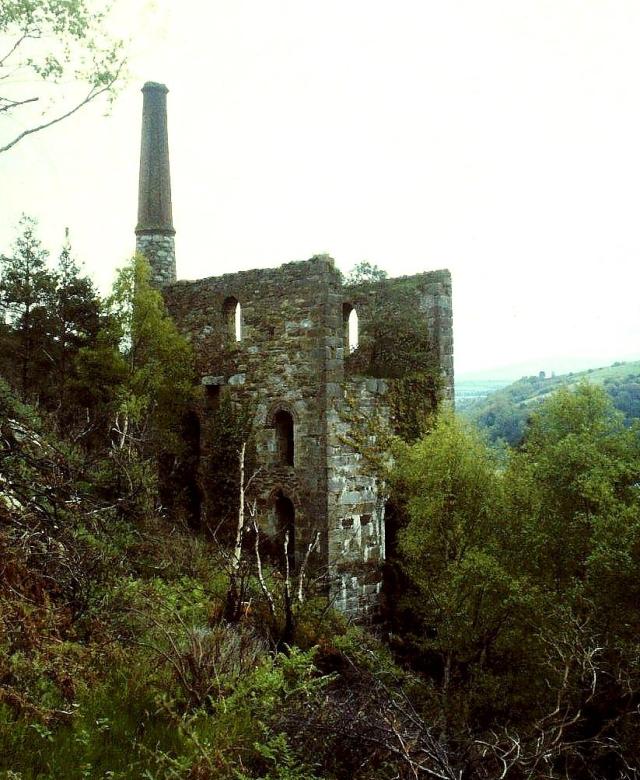









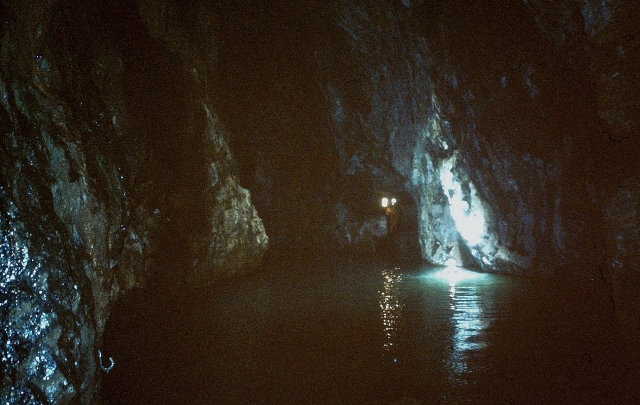


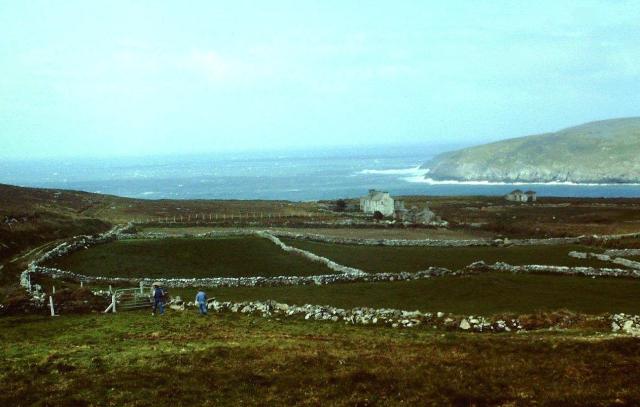



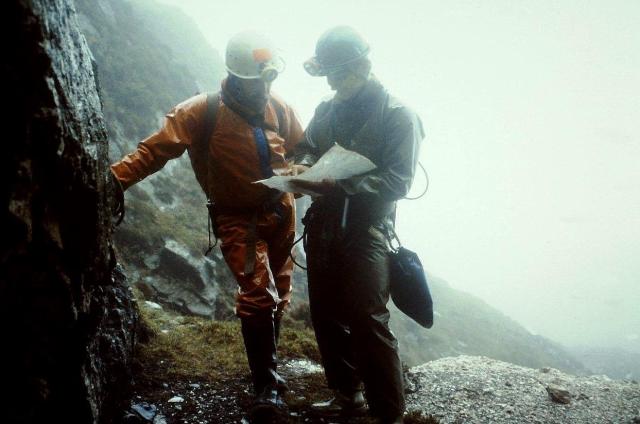




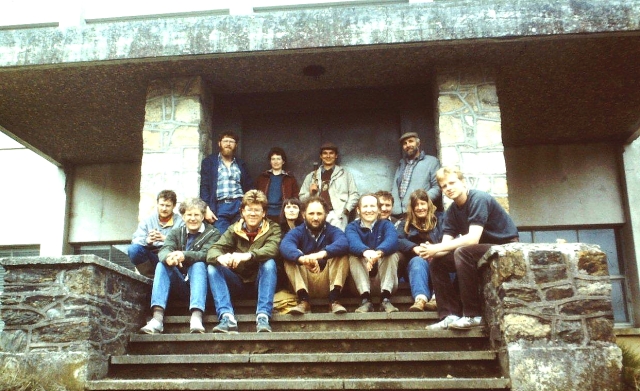













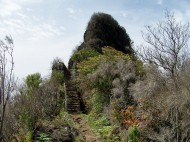
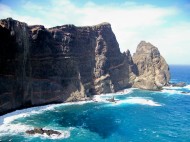


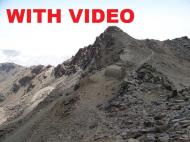




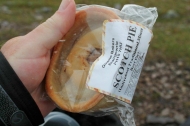



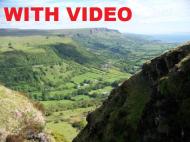

It looks like a very nice trip. It must be very interesting places to explore.
Your experience is very descriptive of the checkpoint. As you say we have become so used to seeing it on TV, but it’s something different to actually be there in front of the soldiers.
I tried this in Jerusalem, the experience remain with me.
Wicklow Mountains looks beautiful. I have visited the website of Wicklow Mountains National Park, it is also interesting reading. I would love to visit the place and see the grove of oaks which the crew of the Sea Stallion planted in Glendalough in Ireland August 14, 2007 in memory of their trip.
Mining History Society, you must know a lot about mining, Alen.
Happy Easter :bear:
Hanna
PS Thanks for sharing the link :-)
Hej Hanna. Yes, men with guns always make me feel uneasy. Nowadays the security presence in Ireland is much more low key, thanks to the peace process. We got caught up in a bomb scare near Londonderry once, me and my family, and that was pretty scary too. But for the people living there it was just part of everyday life.
You must get yourself over to Ireland. Wicklow is a beautiful area and great for walking. And like Denmark, the sun nearly always shines ??? as these photographs show.
Cheers, Alen
I’m working on it. The Ring of Kerry and the Wicklow Mountains would be a unique experience.
Cheers,
Hanna
Spooky but, when I first saw your photo of Dr Merrin I knew he was now dead!
If you think it’s scary visiting Ireland back in those days, you should try Jerusalem now – tanks rumbling around all night long, soldiers with guns all over every street all the time, moslem kids chucking stones at you from rooftops – very uncomfortable and tense place! You can’t blame them though – they’re permanently under attack really…
While I’d like to do some caving, I’d find underground mines too scary – I’d be thinking of the roof collapsing all the time!
Carol.
Hi Carol. I’ve never been to the Middle East but there are places out there I’d really like to visit. I don’t fancy having stones lobbed at my head and being kept awake at night by tanks, though. I expect there are peaceful corners though.
I was into caving and exploring mines in a big way for a lot of years, and the only injury I ever received was a cracked tooth. Walking is far more dangerous. Broke my arm on Pillar once. That was a lesson learned.
Cheers, Alen
Jordan is much to be recommended – superb walking and climbing on lovely, firm sandstone and the best scenery I’ve seen anywhere. The people are friendly in the main, the Beduin more so than what Richard calls the ‘Town Arabs’ – the Town Arabs are very interested in your money so will be nice to you for that reason. The Beduin are just really nice, laid-back people :-)
Carol.
Sounds great. We had a week in Morocco a few years ago and we found the people were really friendly and couldn’t do enough for you. Had a day in the Atlas mountains but no proper walking as such. It’s a beautiful country, mind.
Alen
I may well be taking a trip to there sometime to do some stuff in the Atlas mountains – won’t be this year though… I fancy Oman first though as I’m really missing the desert and theirs looks superb!
Mike Mitchell and Alastair Lings looking at maps
why were the ‘fish & chips’ wrapped in a map ?
Danny, I shall never look at that photograph again without hearing Kenneth Williams’ voice shouting “Frying tonight.”
I still have that plastic covered map. It’s a photocopied geological map from the Scientific Proceedings of the Royal Dublin Society (1964). We were locating the “shafts, adits, gopher holes, etc” marked on it. On the back I have recorded our findings.
Hi Alastair. Great to hear from you. I was going to drop you a line but I’d lost your email address. Now I have it I’ll put it in my address list. I was also going to mention the Killeen poll-pick but I couldn’t remember which museum it went to.
All the best, Alen
The Killeen Poll-pick is in a storeroom at the Geological Survey of Ireland in Dublin. The Mining Heritage Trust of Ireland want to see it on display somewhere, ideally in the Bantry area. Perhaps at the Allihies Copper Mine Museum.
Thanks for that, Alastair
Lovely post that, Alen. As an old caver I could smell the carbide on a few of those photos!
Ah, the smell of carbide. Still got the old lamp somewhere.
Cheers, Alen
Alen, I am only surprised that you survived that cliff abseil in one piece – it looks scary! And that mine shaft…..eeeeeeeekkkkkkk (I would say this and more, going all the way down!) In fact, I don’t think I would be at all happy underground. I wouldn’t mind picking up a gold nugget, though. I used to drag Colin all over the hills in mid Wales with an OS map looking for disused Roman gold mines. Another lovely nostalgic post! Great graphics on the van, by the way! :)
Hi Jo. Van companies knew how to exploit all the high-tech advertising apps n those days. They were really ahead of their time in the North-West.
You didn’t say whether you actually found any Welsh gold, Jo. There’s still plenty in the hills apparently. It’s just a matter of finding it.
Cheers, Alen
Haha, no, Alen – plenty of fool’s gold though! And white quartz! Ah, yes, there’s gold in them there hills… somewhere… (but someone also said there be dragons and I didn’t see any of those either!)
If white quartz was worth anything we’d all be millionaires.
Very happy memories of that trip and it’s predecessor. As I said to you earlier .. The scam of General Sibbald, the butcher of Drogheda was a particularly funny moment (you needed to be there).
Ah, the good old days. I miss having someone to take the mickey out of.
This thread prompted me to go back and look at some of my old slides.
I don’t think it’s possible to add them here so I shall go and scare people elsewhere. I’ve even got a digital slide copier, so watch out.
We seem to lose a few along the way, so many memories of people no longer with us too.
What were we thinking of? Those beards would give ZZ Top a run for their money.
Hey Chris. I want to see those slides so make sure you make them available. And yes, we’ve lost a few old friends. But they will never be forgotten.
All the best, Alen
Hi Fadge – long time since we were in touch! By coincidence, I’m working with two Wicklow groups tracing Wicklow miners who came to Cumberland – I’d like to use some of your Wicklow images in a Powerpoint presentation – is that OK?
Dave Banks
West Cumbria Mines Research Group
Blimey. The original Banksy ??? or the West Cumbria version. Hiya Dave. Good the hear from you. By all means help yourself and best of luck with your project.
Cheers, Alen
Hi Alen,
Looking at the first Wicklow photos, they appear to be of Glendasan mines, west of Rathdrum, rather than Glendalough valley, which has two lakes and less trees in the mined area at the northern end of the lakes. Certainly the engine house photo is Glendasan.
Cheers, Dave
Hi Dave
You are probably correct because it was a long time ago and we did a bit of shifting about between glens. I haven’t got a map handy so I can’t check for certain. Glenmalure also featured. I suppose I should go back and check things out. But I’ve discovered that when I check things out like that, reality is usually completely different to memory.
All the best, Alen